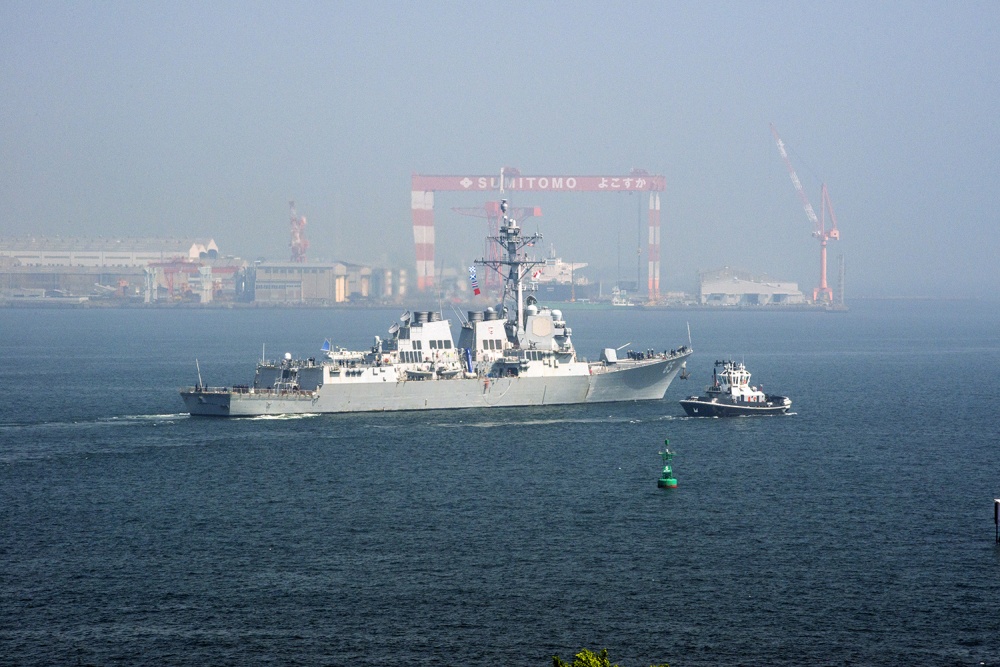
A U.S. warship and fleet replenishment oiler conducted the third transit through the Taiwan Strait in four months as tensions between Taiwan and China are on the rise.
Arleigh Burke-class guided-missile destroyer USS McCampbell (DDG-85) and Henry Kaiser-class oiler USNS Walter S. Diehl (T-AO-193) steamed through the 110-mile-wide body of water separating Taiwan from mainland China in what the U.S. Navy described as a “routine passage,” Navy officials confirmed to USNI News.
“The ships’ transit through the Taiwan Strait demonstrates the U.S. commitment to a free and open Indo-Pacific. The U.S. Navy will continue to fly, sail and operate anywhere international law allows,” Lt. Cmdr. Tim Gorman told USNI News in an email.
Thursday’s mission was different from other recent Navy freedom of navigation operations (FONOPs) missions. In this case, U.S. policy does not dispute China’s claim over Taiwan, and the transit followed international law which allows for vessels to move directly through territorial sea without performing military exercises.
In October, Arleigh Burke-class guided-missile destroyer USS Curtis Wilbur (DDG-54) and Ticonderoga-class guided-missile cruiser USS Antietam (CG-54) passed through the sea lane. A month later, Arleigh Burke-class guided-missile destroyer USS Stockdale (DDG-106) and Henry Kaiser-class fleet replenishment oiler USNS Pecos (T-AO-197) steamed through the same shipping lane.
China maintains a policy of insisting foreign warships ask permission and provide advance notice of their intent to transit through its territorial waters. However, China’s policy is not in accordance with international maritime law, according to a Tufts Univesity Law of the Sea Policy Primer. Since international maritime law does not require advance notice, the U.S Navy does not honor China’s request, which generally irritates the Chinese government.
CNN first reported McCampbell and Walter Diehl’s Taiwan Strait transit.
The transit comes as there’s been a growing sense of cross-strait animosity between the leadership in Beijing and Taipei. Taiwanese President Tsai Ing-wen and Chinese President Xi Jinping reportedly gave very different views of how the island and mainland should interact, according to media reports.
In dueling New Year’s speeches, Xi reportedly suggested it was time for reunification of China by adopting what is called a “One Country Two Systems” model of governing. In response, Tsai reportedly said Taiwan would never accept the “One Country Two Systems” model, according to an account in the Hong Kong-based South China Morning Post.
Then on Wednesday, China sent a Sukhoi Su-30 fighter jet and a Shaanxi Y-8 transport plane into the airspace near Taiwan, according to media reports.

In contrast to today’s event, two a half weeks ago McCampbell sailed past the Paracel Islands in the South China Sea as part of a FONOP. Since the 1990s China has claimed a straight baseline around the entire archipelago, a move not recognized by international law. Vietnam and Taiwan also claim the chain of islands.
McCampbell’s route past the Paracel Islands was intended to contest an excessive maritime claim, a Navy spokesperson told USNI News.
McCampell and Diehl’s Thursday’s transit, and the recent FONOP, both occurred without incident, according to the Navy.
During a recent visit to Beijing, Chief of Naval Operations Adm. John Richardson discussed safe maritime operations, including routine transits and FONOPs, with his counterpart from the Chinese People’s Liberation Army Navy, Vice Adm. Shen Jinlong.





